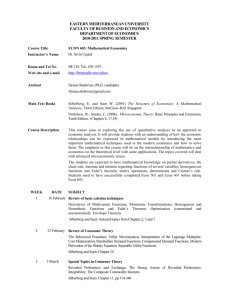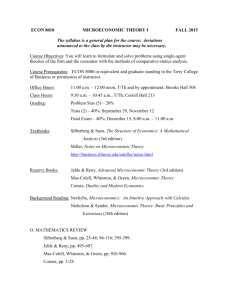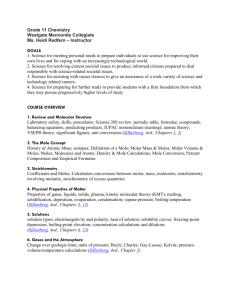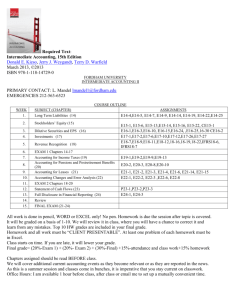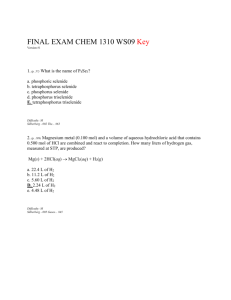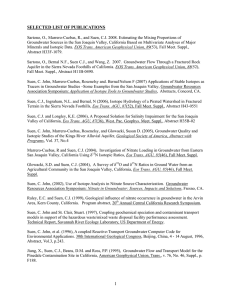City Universtiy of New York
advertisement
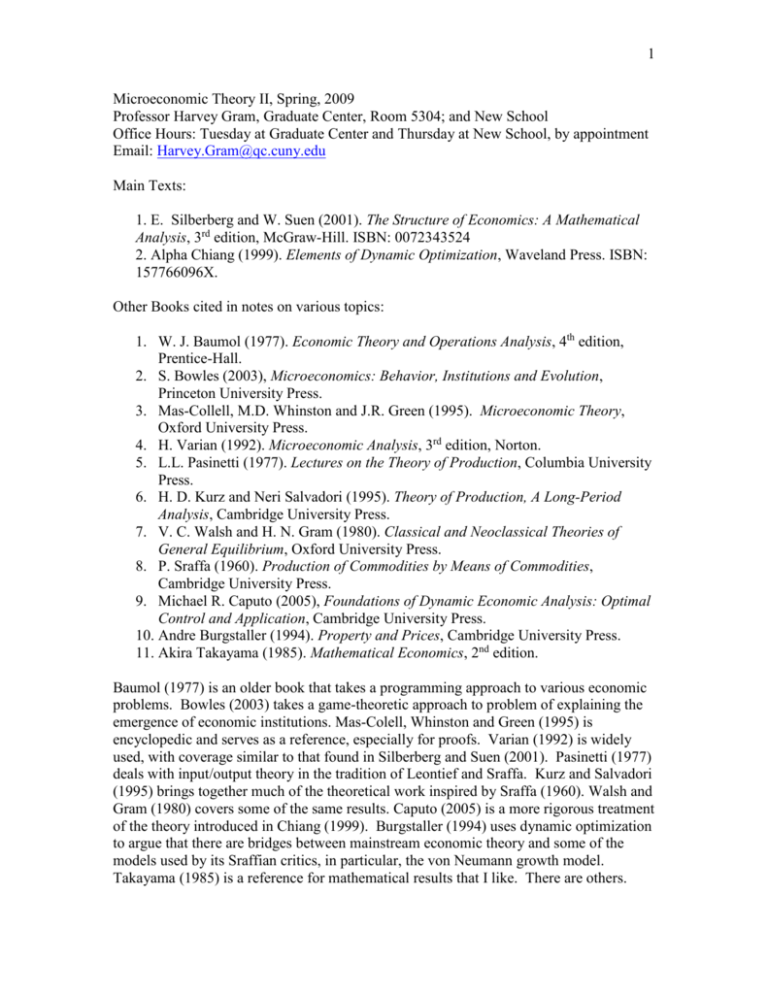
1 Microeconomic Theory II, Spring, 2009 Professor Harvey Gram, Graduate Center, Room 5304; and New School Office Hours: Tuesday at Graduate Center and Thursday at New School, by appointment Email: Harvey.Gram@qc.cuny.edu Main Texts: 1. E. Silberberg and W. Suen (2001). The Structure of Economics: A Mathematical Analysis, 3rd edition, McGraw-Hill. ISBN: 0072343524 2. Alpha Chiang (1999). Elements of Dynamic Optimization, Waveland Press. ISBN: 157766096X. Other Books cited in notes on various topics: 1. W. J. Baumol (1977). Economic Theory and Operations Analysis, 4th edition, Prentice-Hall. 2. S. Bowles (2003), Microeconomics: Behavior, Institutions and Evolution, Princeton University Press. 3. Mas-Collell, M.D. Whinston and J.R. Green (1995). Microeconomic Theory, Oxford University Press. 4. H. Varian (1992). Microeconomic Analysis, 3rd edition, Norton. 5. L.L. Pasinetti (1977). Lectures on the Theory of Production, Columbia University Press. 6. H. D. Kurz and Neri Salvadori (1995). Theory of Production, A Long-Period Analysis, Cambridge University Press. 7. V. C. Walsh and H. N. Gram (1980). Classical and Neoclassical Theories of General Equilibrium, Oxford University Press. 8. P. Sraffa (1960). Production of Commodities by Means of Commodities, Cambridge University Press. 9. Michael R. Caputo (2005), Foundations of Dynamic Economic Analysis: Optimal Control and Application, Cambridge University Press. 10. Andre Burgstaller (1994). Property and Prices, Cambridge University Press. 11. Akira Takayama (1985). Mathematical Economics, 2nd edition. Baumol (1977) is an older book that takes a programming approach to various economic problems. Bowles (2003) takes a game-theoretic approach to problem of explaining the emergence of economic institutions. Mas-Colell, Whinston and Green (1995) is encyclopedic and serves as a reference, especially for proofs. Varian (1992) is widely used, with coverage similar to that found in Silberberg and Suen (2001). Pasinetti (1977) deals with input/output theory in the tradition of Leontief and Sraffa. Kurz and Salvadori (1995) brings together much of the theoretical work inspired by Sraffa (1960). Walsh and Gram (1980) covers some of the same results. Caputo (2005) is a more rigorous treatment of the theory introduced in Chiang (1999). Burgstaller (1994) uses dynamic optimization to argue that there are bridges between mainstream economic theory and some of the models used by its Sraffian critics, in particular, the von Neumann growth model. Takayama (1985) is a reference for mathematical results that I like. There are others. 2 Topics. 1. Optimization and Duality Silberberg and Suen (2001), chapters 6-11; Varian (1992), chapters 1-9 - first and second order conditions, quadratic forms the envelope theorem and comparative statics profit functions, cost functions, expenditure functions: elasticity restrictions Le Châtelier results functional forms in estimation 2. Linear and Non-linear Programming Silberberg and Suen (2001) chapters 14 and 17 Baumol (1977), chapters 5-8 W.J. Baumol and M.L. Balinski (1968). “The Dual in Nonlinear Programming and its Economic Interpretation,” Review of Economic Studies, Vol. XXXV, pp. 237-56. In Selected Economic Writings of William J. Baumol (1977), chapter 23. - primal and dual problems saddle points rent and the non-linear dual 3. General Equilibrium R.W. Jones (1965), “The Structure of Simple General Equilibrium Models,” Journal of Political Economy, December. R.W. Jones and J. Scheinkman (1977), “The Relevance of the Two-Sector Production Model in Trade Theory,” Journal of Political Economy, October. P.A. Samuelson (1953), “Prices of Factors and Goods in General Equilibrium,” Review of Economic Studies, Vol. XXI, pp. 1-20. Silberberg and Suen (2001) chapter 18 Varian (1992), chapter 21 4. Leontief/Sraffa input-output models Pasinetti (1977), chapters 4-6 Walsh and Gram (1980), chapters 11, 12, 13, and 15 5.Time Silberberg and Suen (2001), chapters 12 and 20 Varian (1992), chapter 19 and 20 Chiang (1999). 3 6.Risk Silberberg and Suen (2001), chapters 13 Varian (1992) chapter 11 7.Agency Silberberg and Suen (2001), chapters 15 Varian (1992) chapter 25 8.Information Silberberg and Suen (2001), chapters 16
